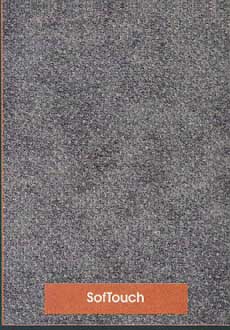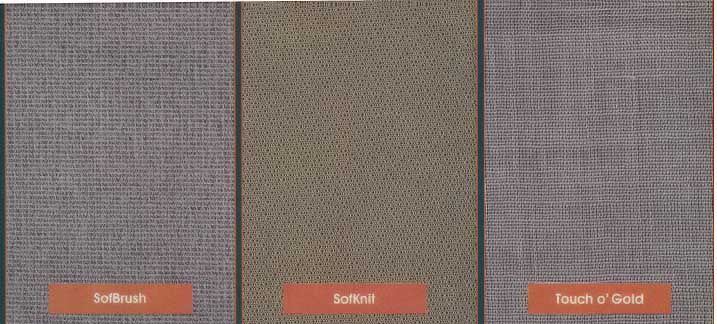Low-temperature fusibles are the solution for heat-sensitive synthetics.


The new low-temperature fusibles for lightweight fabrics
come in four variations, providing a choice of texture and stretch or support
for most situations. All photos are approximately life-size, with the lengthwise
grain vertical.
You’d think that fusible interfacings would be a perfect match for the current crop of fabrics from the chemists’ labs—the micro fibers, ultralight polyesters, and faux suedes—since fusibles are almost all synthetic, too. And, except for one problem, you’d be right.
The problem is that the heat needed to apply most fusibles is often enough to damage these heat-sensitive fabrics. To deal with this, textile chemists have recently devised new adhesives that work at lower, safer “silk” temperatures, rather than the “wool” setting that earlier fusibles required. These adhesives are applied to lightweight interfacing fabrics that are now becoming avail able to home sewers. Here’s how to select and apply these low-temperature newcomers to your own sewing projects.
The choices
The chief sources at present for low-temp. fusibles are Dritz Corp. and Handler Textile Corp., known as HTC. Dritz has a new product called Soft’n’Silky, which is de scribed below. HTC has four new interfacings which have been designated Cool Fuse, designed to cover a wide range of temperature-sensitive needs; these are shown in the photos above. Two of the new products are brushed to create a slight loft, for fabrics with texture, such as faux suedes and washed silks. Two are smooth and thin, meant for crisp, smooth- surfaced lightweights like the smooth microfibers and silkies. (Don’t hesitate to mix them up; I’ve had good results with all of these interfacings on many different kinds of fabric.) Within each type, one is stretchy in all directions, or all- bias, and the other provides at least some stability in one or two directions.
The brushed interfacings—The two brushed offerings from HTC are SofTouch and SofBrush. SofTouch is a very lightweight all-nylon nonwoven available in black and white. It’s got lengthwise stability so it can be used in facings and any place else where nonstretch is needed, like behind pockets and buttonholes.
SofBrush is all-polyester, available in white, ivory, gray, and black. It has a new textile structure called warp insertion, which means that it’s a knit fabric with additional yarns inserted in the length wise direction. Unlike weft insertions, which look similar but are stable both cross- and lengthwise, the extra yarn doesn’t add stability. SofBrush is all-bias, which allows for complete drapability in all directions. It’s a good choice for soft tailoring in mid- to heavyweight dress fabrics or lightweight suitings, and it combines equally well with knits or wovens. As with other all-bias interfacings, SofBrush’s crosswise grain has the most stretch, so if you want maximum flexibility in a particular area of the garment the collar, for example—cut SofBrush so that the fold is on the cross grain. Dritz’s Soft’n’Sitky is almost identical to SofBrush; all of the above applies to it, as well.
The smooth pair—The non-brushed low- temp. offerings from HTC are called SofKnit and Touch o’ Gold. SofKnit is an all-nylon knit structure called tri-dimensional that results in a fabric with true all-bias stretch, unlike regular (tricot) knit interfacings, which are more stable in the lengthwise direction. It’s available in white, black, and champagne, and can be used on knits and woven fabrics, allowing complete drapability.
Touch o’ Gold is a feather weight woven rayon (stretchy only on the bias) available in white, ivory, and black, whose fusible surface is unique. Be sides being low-temp., it’s also called “gentle-hold” by the manufacturer. Because typical fusing resins often penetrate to the right side of sheer, lightweight fabrics (the technical term is strike-through), HTC devised a lighter coating that avoids the problem. It also doesn’t stick as firmly, so they dubbed it a hybrid: a fusible/sew-in. If it comes off even partially after cleaning, or if you pull it off on purpose, it can be re fused any number of times, and it’s a good idea to catch it in the seam allowances so that the stitching holds it permanently in place. I’ve found Touch o’ Gold to fuse quite solidly, using the method described on the facing page, if it's laundered gently.
Testing a fusible
All types of fusing require four factors for success: heat, time, moisture, and pressure. Manufacturers’ recommendations for low-temp. fusing call for a “silk” heat setting, applied for 10 seconds, with steam and light pressure. Because irons and fabrics differ, testing is a necessity. I like to cut about a 4- by 6-in, swatch of preshrunk fashion fabric and fuse a similar size piece of preshrunk interfacing to it, leaving about an inch of interfacing on the length and width unfused, as I’ll explain below. Here’s the method I use to fuse: First, check your fabric for water spot ting by sprinkling a scrap and pressing it dry. If it spots, you can try to get a bond with a dry press cloth along with steam from your iron. However, many irons don’t steam evenly on the silk setting, requiring you to spray the press cloth.
A practical solution is to use two layers of ordinary white wrapping tissue as a press cloth. I’ve gotten excellent results, with no water spotting, as long as I’m careful to spray the paper from at least 12 in. away so it’s just misted. I’ve found that I get a better bond with all fusibles using the tissue instead of a cloth, and if the resin strikes through the fusible, it doesn’t ruin a good press cloth.
Press firmly for 10 seconds. Don’t slide the iron from place to place, but after about 5 seconds, jiggle the iron a bit so the holes in the soleplate don’t leave an impression on the fabric. Overlap iron positions if necessary. Allow the project to cool before handling, then turn it over and , using a fabric press cloth, repeat the pressing process from the right side to ensure a smooth, even bond.
When the interfacing has cooled a bit, check the adhesion by tugging on a corner. Unless the interfacing is Touch o’ Gold, it shouldn’t pull up. Fold it and feel it. Does it have the characteristics you want it to have? Did any resin strike through? If it did, the interfacing is too heavy. If the fabric is a bit transparent, did the color change? If so, try a more sheer interfacing, or a beige tone. Did the structure of the interfacing show through? If the garment is washable, it’s a good idea to put a test sample of inter facing through the same type of laundering procedure the garment will get. Baste the edges if you’re using Touch o’ Gold, or you may lose the interfacing.
If the bond isn't satisfactory, repeat the process, increasing the time, the pres sure, the moisture (very cautiously), and , only as a last resort, the heat. When all else fails, try another fusible, or consider using a sew-in. Some fabric finishes resist fusibles of all sorts.
Pre-shrinking and laundering
Because the worst problems that fusibles create come from shrinkage, I feel that it’s important to preshrink all of them. You can do this without harming the interfacing or the resin by placing the folded piece into hot water and leaving it there until the water has cooled. Place the interfacing on a terry-cloth towel to drain, then spread it out on nylon carpeting so it can dry flat. The hot water will not disturb the resin but agitation can, so be sure to handle the interfacing gently during the preshrinking process. I preshrink all of my fusibles this way before I store them, so I never have to wonder if I’ve preshrunk the piece that I’m about to use. Of course, the fashion fabric should be preshrunk before fusing as well.
I leave a little of the fusible unfused in my test because that can help show whether I need to preshrink even further. If there’s any rippling or curling of either interfacing or fabric at the fused edge, it’s an indication of a slight shrink age which might not show up if the entire piece was fused. Laundering may result in bubbling, which is another indication of further shrinkage. The shrinkage may be from either the fabric or the interfacing, so you should test both.
For example, rayon and cotton can continue to shrink even after an initial washing. On the other hand, interfacings with a high nylon or polyester content are subject to further shrinkage from heat and often need steam shrinking in addition to immersing them in water as discussed earlier. You can steam shrink right be fore you fuse, holding the steaming iron about 1/2 in. above the interfacing with the resin side down against the wrong side of the fabric to which it's to be fused. After the piece seems well-steamed, fuse it onto the fabric starting in the center and working toward the ends, following the fusing directions above.
